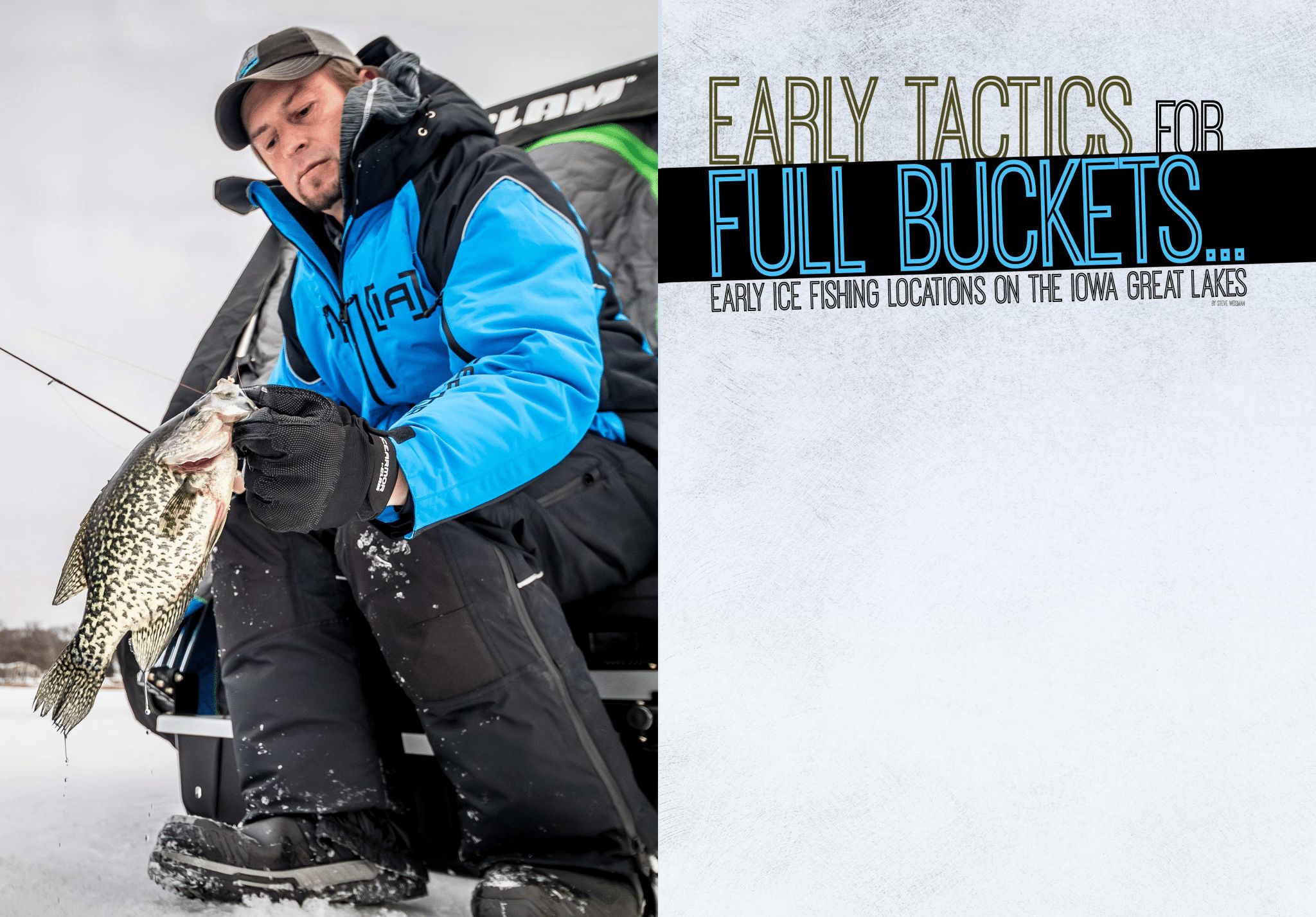Early Tactics for Full Buckets

Early Tactics for Full Buckets
Once the calendar turns to November, anglers in the Ice Belt begin praying for several sub-freezing days and nights to get that first sold ice on fishable waters. Here on the Iowa Great Lakes that can be early as Thanksgiving but most usually around the middle of December. Now that doesn’t mean that the main lakes ae frozen and safe. However, back bays, canals, and the smaller bodies of water have the potential to be fishable for bluegills, crappie, and perch.
Think safety first
First ice is always dynamite action, and people are always antsy to catch the early ice bite…BUT, I always follow this philosophy when I am going out on any ice: Not all ice is created equal! In other words, ice thickness will vary from spot to spot even on the same area of the lake and certainly from one lake to another. I’ve seen it many times. A couple of nights down in the single digits and daytime temperatures in the 20s, and with ice barely two inches thick…you’ll have people giving ice fishing a try. However, that’s really pushing the envelope, almost like playing Russian roulette, so to speak.
Before you go out, use common sense and be prepared. Wear a life vest under your winter gear, or better yet wear one of the new flotation ice fishing suits such as the motion float technology designed by Clam Outdoors in its Ice Armor suits. And it’s a good idea to carry a pair of ice picks if you do happen to break through. On clear ice, always use a good set of ice cleats. Lots of sprains and broken bones occur each winter when people try to walk on glare ice without some type of ice cleat.
Ice guidelines
Each state across the northern Ice Belt puts out safety guidelines anglers can use when considering ice fishing. According to ice safety experts, stay off ice that is three inches or less in thickness. Four inches of solid, clear ice is the minimum to support one angler. Be careful of fishing alone in case something happens, but a group of anglers should not walk out together on four inches of ice. It’s wise to check ice depth as you move out deeper.
At the same time, there are other considerations. Watch out for bridge areas and other current areas, areas where water is entering the lake, shallow rocky areas or weedy areas.
Remember, snow on top of the ice slows down the freezing process.
A look at the Iowa Great Lakes
First fishing ice occurs on the canals of West Okoboji, the Grade on the north end and the Templar Park boat ramp on the southwest side of Big Spirit. The canals are surrounded by private property, so you need to have permission to access them from shore. These areas are shallower and more protected, so they freeze first. These areas all provide good bluegill, crappie and perch opportunities. Shortly after, Upper Gar, a shallow lake between East Okoboji and Lake Minnewashta, will freeze up and offer some great panfish action, followed by Lake Minnewashta. These areas are sometimes relatively clear water, so if you have a portable shelter, you might be able to see the fish movements below. If not, I always make sure I have my Vexilar FL-28 flasher and Vexilar Scout underwater camera along.
The next areas to freeze over include Angler’s Bay on Big Spirit and finally Little Emerson Bay on West Okoboji, followed by Big Emerson Bay, Miller’s Bay and Smith’s Bay-all on West Okoboji. Depth now will be 4-5 feet on out to 10-12 feet deep. These main lake bays on West Okoboji and quite often Angler’s Bay on Big Spirit are all clear water areas, and that means sight fishing. However, this also can cause a problem, because these panfish are sight-feeders and as a result, these fish want the presentation just right.
Location is also a big key, and I totally believe in the Dave Genz philosophy of mobility. Keep moving until you find the fish. When you fish these bays, a big key is finding standing weeds with “passage areas” for the panfish to move through. I often target late fall panfishing areas (using GPS), where I think there still might be good standing weeds. If it’s my first time to this area, before fishing, I will punch some holes and use my Scout Underwater Camera to survey the bottom looking for those patches of weeds. If I’m lucky I might find some panfish in the distance.
Equipment
First off, I have gone to mono that is as small as one-pound test, but more often I use two-pound test until late in the winter. For years, I used a spinning reel and ultralight rod and a spring bobber. However, with the coils from the spinning reel, I would have trouble with my lure spinning. I could get it to stop, but it was a pain to be working on that when a big gill was sitting down there. So, I’ve gone to a Dave Genz Spooler Gravity Elite reel matched with a 22” ultra-light action. The spooler, like a fly reel, releases line out the front which helps alleviate the lure spinning.
Lures and baits
Think small and think finesse. Although my ice fishing tackle box is full of lures, my go-to is the series of Clam tungsten jigs. I like tungsten jigs because they weigh more than lead, get down in the fishing zone more quickly and respond well to the way I work them. Yet, their size is smaller than that of a comparably weighted lead jig. My top choice is the 1/32-ounce Dingle Drop. I think the little chain is a great attractor. Glow red is my favorite color. When the gills get really finicky, I go to the glow red 1/64-ounce Drop jig. There are many companies that make tungsten jigs, so anglers have a wide range of options. Whatever bait you use, it is important that the lure be tied so that it doesn’t spin. Finicky panfish will back away if the lure is spinning.
Lure movement needs to be subtle, but watch the fish as they come in. They will react to the movement of your bait. The good news is early ice usually means aggressive fish, and the finesse movements needed later in the year aren’t quite as important. Live bait like silver wigglers or wax worms work well as do Maki Plastics.
Presentation
For these panfish, the right movement triggers the fish to bite. The fish will tell you what they like. However, my first presentation is a subtle jiggle, jiggle, jiggle action. If the fish is aggressive and keeps on coming, I keep on moving the lure exactly the same. However, if the fish stops and stares, then it’s time for plan “B”. If I haven’t fished these fish before, it becomes a guess. Maybe they want it dead still – no movement at all. So, I’ll do that. If they begin to slowly fin back and away, I will try to very subtly jiggle the bait, and if the fish responds, I will slowly bring the lure up a bit, continuing to jiggle the bait.
I do know this, however: if a fish comes into the zone and you are working a jig in a certain manner, DO NOT change what you are doing. If you do, these sight-reliant fish will often simply back off. Remember to work the water column up and down. There certainly are levels of frustration. I’ve had huge panfish bump the jig with their nose-mouth closed and then watch it dangle there. I’ve had them take just the tip and hold it in their mouth. No way I can set the hook. Then, I’ve had them put the head of the jig in their mouth, hold it there and then just spit it out. But that’s the fun of it! Above all, don’t get discouraged. The more you do this type of fishing, the more comfortable and skilled you will become.
I can’t wait until the first solid safe ice, because I know what that means: fish on the bite!
by Steve Weisman
December 2020


